Vera Molnár
QUOTES
“If you replace the word ‘random’ with ‘intuition’, there you have it. With intuition, suddenly you say – now what if I used a curve instead of a straight line and what sort of a curve? And then you try it – that’s intuition. Randomness does the same thing” https://vintage.hu/wp-content/uploads/2019/03/Molnar-Vera-HUO-interview.pdf
‘I have no regrets. My life is squares, triangles, lines’
https://www.studiointernational.com/index.php/vera-molnar-interview-computer-art-paris-mayor-gallery
On her approach: “Attuned from childhood to the possibilities of a system-based art, Molnár conjured up a “machine imaginaire” whose hypothetical programmes altered the concrete bones of her images, rotating, disordering, and fracturing specific elements in multiple iterations.”
“Avoiding premeditation, Molnár fine-tunes her programmes as the works unfold, favouring an instinctive method that enables greater receptiveness to the unpredictable, an approach she has called “the conversational method”.”
“Proceeding by small steps, the painter is in a position to delicately pinpoint the image of dreams. Without the aid of a computer, it would not possible to materialize quite so faithfully an image that previously existed only in the artist’s mind. This may sound paradoxical, but the machine, which is thought to be cold and inhuman, can help to realize what is most subjective, unattainable, and profound in a human being.” Quoted in Digital Art: Painting with Pixels
Toward Aesthetic Guidelines for Paintings with the Aid of a Computer “I am a painter, an image-maker, in particular, of images of a nonfigurative kind. I ‘create’ visual forms in the sense that they consist of combinations of shapes that cannot be found in nature.” https://arena-attachments.s3.amazonaws.com/3925408/e77cfae32bd916141e6f2b2f7964a14a.pdf?1553439831
“Between 1959 and ’68, when she was first able to program a mainframe computer to make drawings, Molnar imagined herself to be a drawing machine, a “Machine Imaginaire.””
https://hyperallergic.com/437834/vera-molnar-drawings-1949-1986-senior-and-shopmaker-gallery-2018/
Machine imaginaire vs. machine réelle → computer as formal instrument
“To genuinely systematize my research series I initially used a technique which I called machine imaginaire. I imagined I had a computer. I designed a programme and then, step by step, I realized simple, limited series which were completed within, meaning they did not exclude a single possible combination of form. As soon as possible I replaced the imaginary computer, the makebelieve machine by a real one.”
http://dam.org/artists/phase-one/vera-molnar/artist-s-statement ^ Artist’s statement
https://twitter.com/oiioiioioiiioio/status/1186931015756996608
^^ Video from MuDA talking about what happens when you explore “randomness” + “iteration”
“My final aim, in common with so many painters of history, is to be able to create valuable works of art in a conscious way. Conscious way does not mean in my opinion the suppression of intuition, but its reinforcement by a cognitive process; it does not mean that painting becomes a matter of logic. Art at its inception is essentially intuitive, it is in its elaboration that intuition needs control and aid by cognition.”
The Artist Who Drew With Computers, Before Computers Were a Thing
Vera Molnar : A Cognitive Process
“Proceeding by small steps, the painter is in a position to delicately pinpoint the image of dreams. Without the aid of a computer, it would not possible to materialize quite so faithfully an image that previously existed only in the artist’s mind. This may sound paradoxical, but the machine, which is thought to be cold and inhuman, can help to realize what is most subjective, unattainable, and profound in a human being.” From Frank Popper’s Visualization, Cultural Mediation and Dual Creativity in Leonardo.
In order to systematically process her research series, she invented a “technology”, which she called “Machine Imaginaire”.
“Vera Molnar holds that the computer can serve four purposes. The first concerns its technical promise—it widens the area of the possible with its infinite array of forms and colors, and particularly with the development of virtual space. Secondly, the computer can satisfy the desire for artistic innovations and thus lighten the burden of traditional cultural forms. It can make the accidental or random subversive in order to create an aesthetic shock and to rupture the systematic and the symmetrical. For this purpose a virtual data bank can be assembled. Thirdly, the computer can encourage the mind to work in new ways. Molnar believes that artists often pass far too quickly from the idea to the realization of the work. The computer can create images that can be stored for longer, not only in the data bank but also in the artist’s imagination. Finally, Molnar thinks that the computer can help the artist by measuring the physiological reactions of the audience, their eye movements for example, thus bringing the creative process into closer accordance with its products and their effects.” Visualization, Cultural Mediation and Dual Creativity, Frank Popper
Vera Molnár on creating new vocabulary for her art, specifically “livrimage”:
“It is a contraction, a reduction by welding of two linguistic elements: book and image, as the object itself is contraction. A series of images that you can leaf through, like a book, but that cannot be read: you look at yourself. There is neither subject nor history in the literary sense of the word. Images are produced, followed, explained, developed, destroyed, remade, renewed”.
“Aware that our critical exercise, paradoxically, comes to separate what Véra Molnar is trying to reconcile since, obviously, the reader of these lines is not confronted with the works themselves but with a discourse which takes them up and distances ourselves from it, we formulate the request that our sentences as soon as read be forgotten and replaced by the desire, and its satisfaction, to leaf through the livrimages of Vera Molnar.”
WORKS
Varied + Recent Works:
http://www.veramolnar.com/
https://www.pinterest.com/e_vigier/vera-molnar/
http://dam.org/artists/phase-one/vera-molnar/artworks-bodies-of-work


















https://www.galerie-ba.com/vera-molnar-eng
Lines:








Rectangles:





Triangles + Circles:




















Series: Square Positions:




Series: Structure de Quadrilatères:





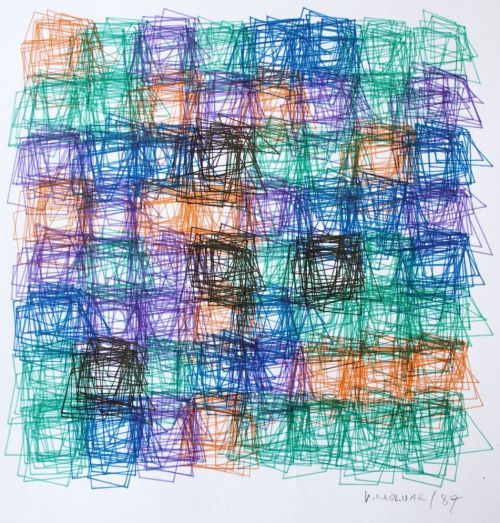


![]()

Series: Hommage à Dürer:





Series: Hommage à Klee:
Based of a geometric picture of Paul Klee Vera Molnar examines the result of a transformation of the picture by computer and by hand-drawing:





Series: Hommage a Monet:




Series: Sainte Victoire:




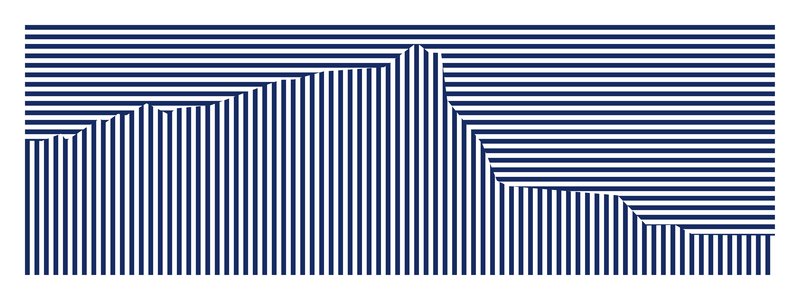







Series: Quatre Carrès:






Series: Gothique:
The series ‘Gothique’ was created on the occasion of a commissioned work for the German-French exhibition ‘Construction and Conception’.
The show was arranged for the station Schöneberg in Berlin which was still shut down back in 1988. Vera Molnar implemented a work on the windows of the railway’s hall. The installation picks up the existing architectonic structures of the glass front - high and slender like
the gothic ideal.
**“The work is based on an intense reflection concerning proportions. After I had left one of the ideals of forms, the square, behind and lengthened it, I did not go any further than the proportions of the golden ratio allowed… After the cube, after the rectangle based on the rules of the golden ratio, I stuck to the double cubes, the quadruple cube, arriving at the ‘wild’ proportions in the end, e.g. 1:30. In this case it was hardly a rectangle anymore, rather a thick line. More precisely, you find yourself visually ‘in between the two’: neither line nor bar… These elongated rectangles, gothic, truly amazed me as antipodes to the canon of ancient beauty. It was like a healthful shaking at the point on which I had been comfortable with my aesthetic understanding.’ Vera Molnar interviewed by Marc Chauveau, 2010.






https://dam-gallery.de/kuenstler_ui/vera_molnar/?lang=en#1522142020853-7ccabfe9-20e0
Series: Interruptions:



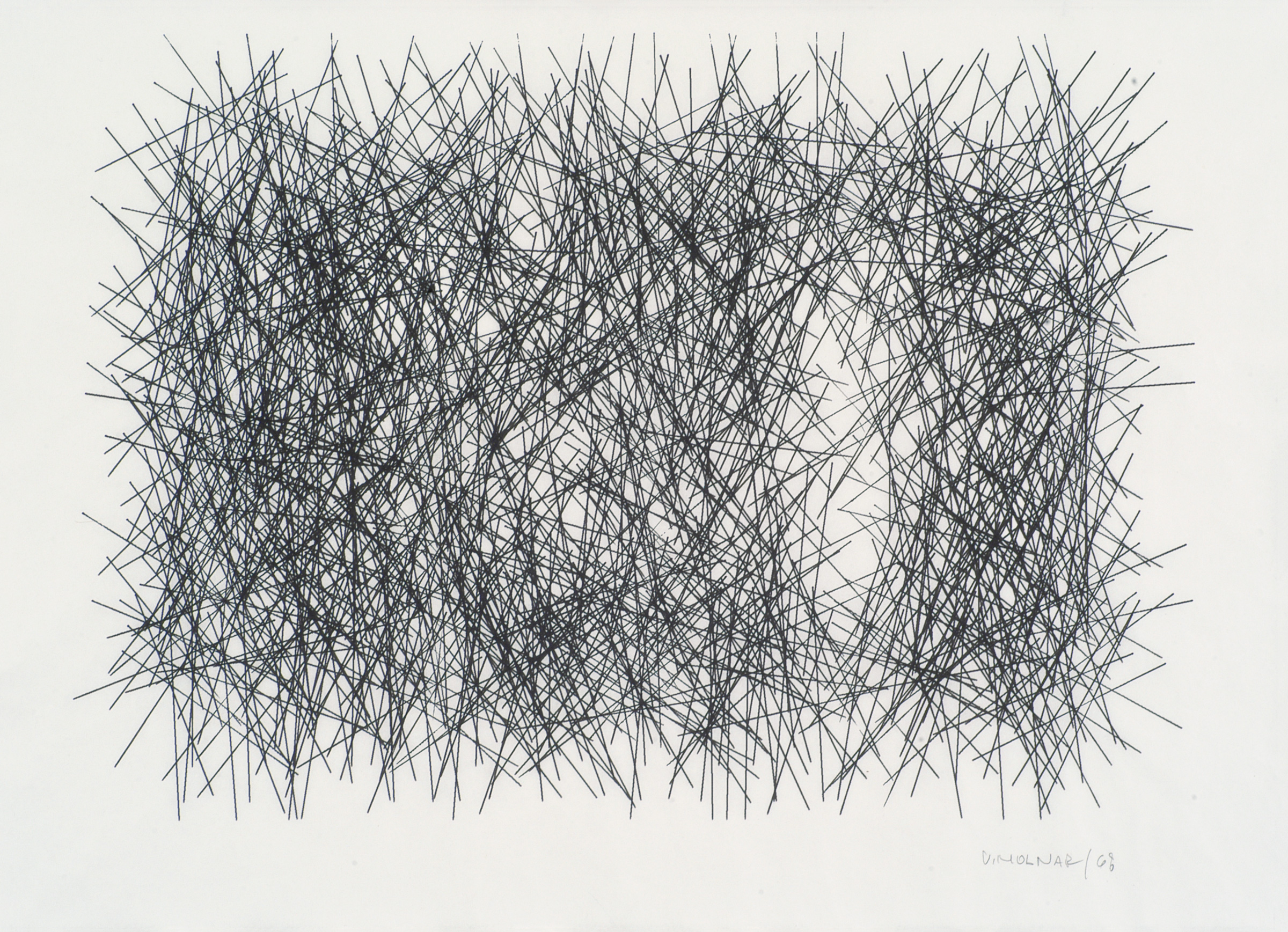
Series: Transformations + Hypertransformation:


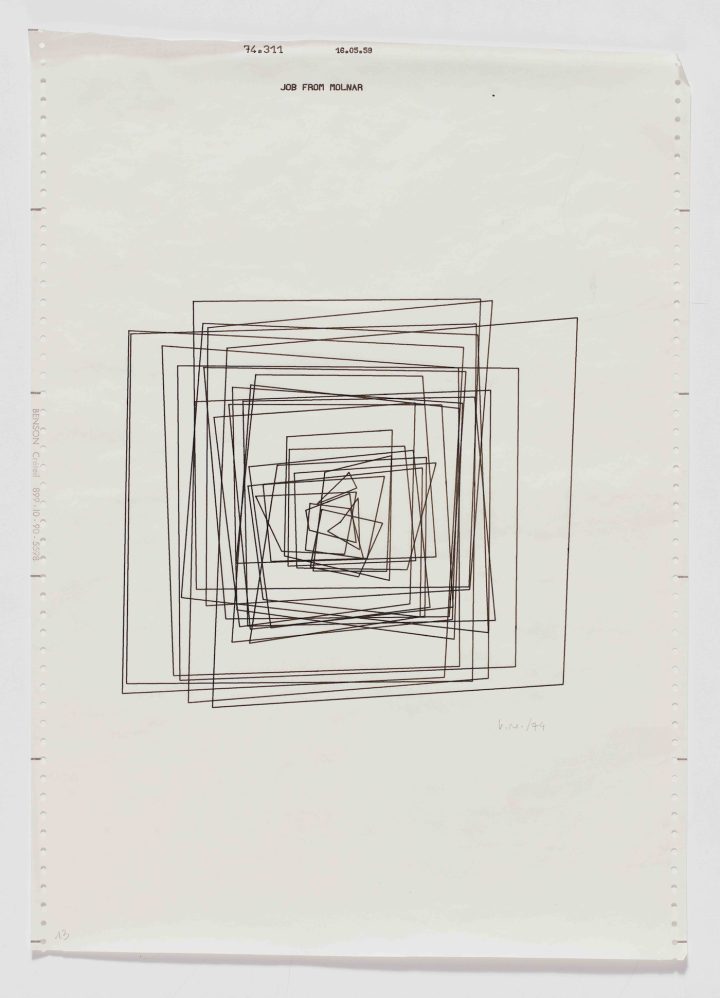




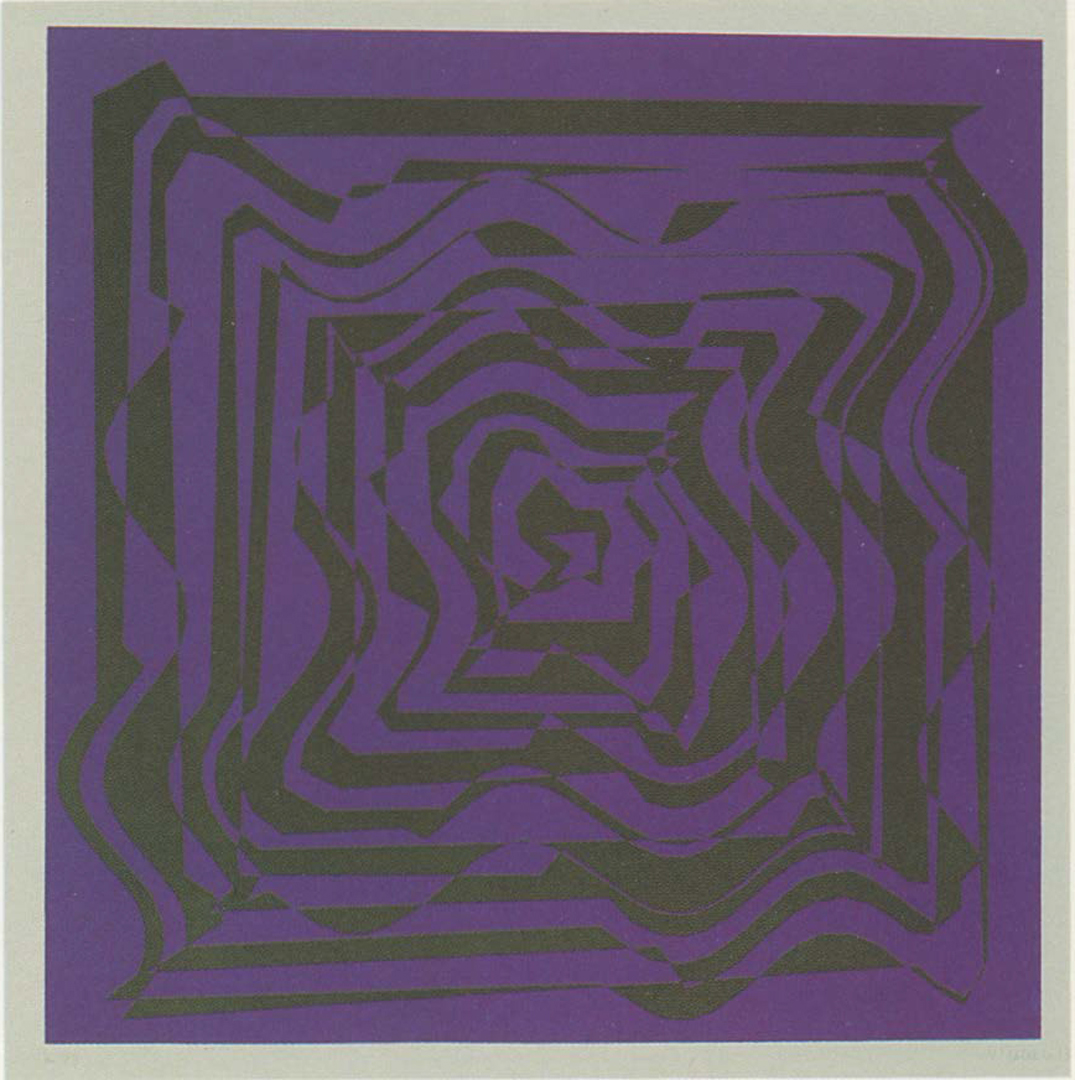
https://digitalartarchive.siggraph.org/artwork/vera-molnar-hypertransformations/

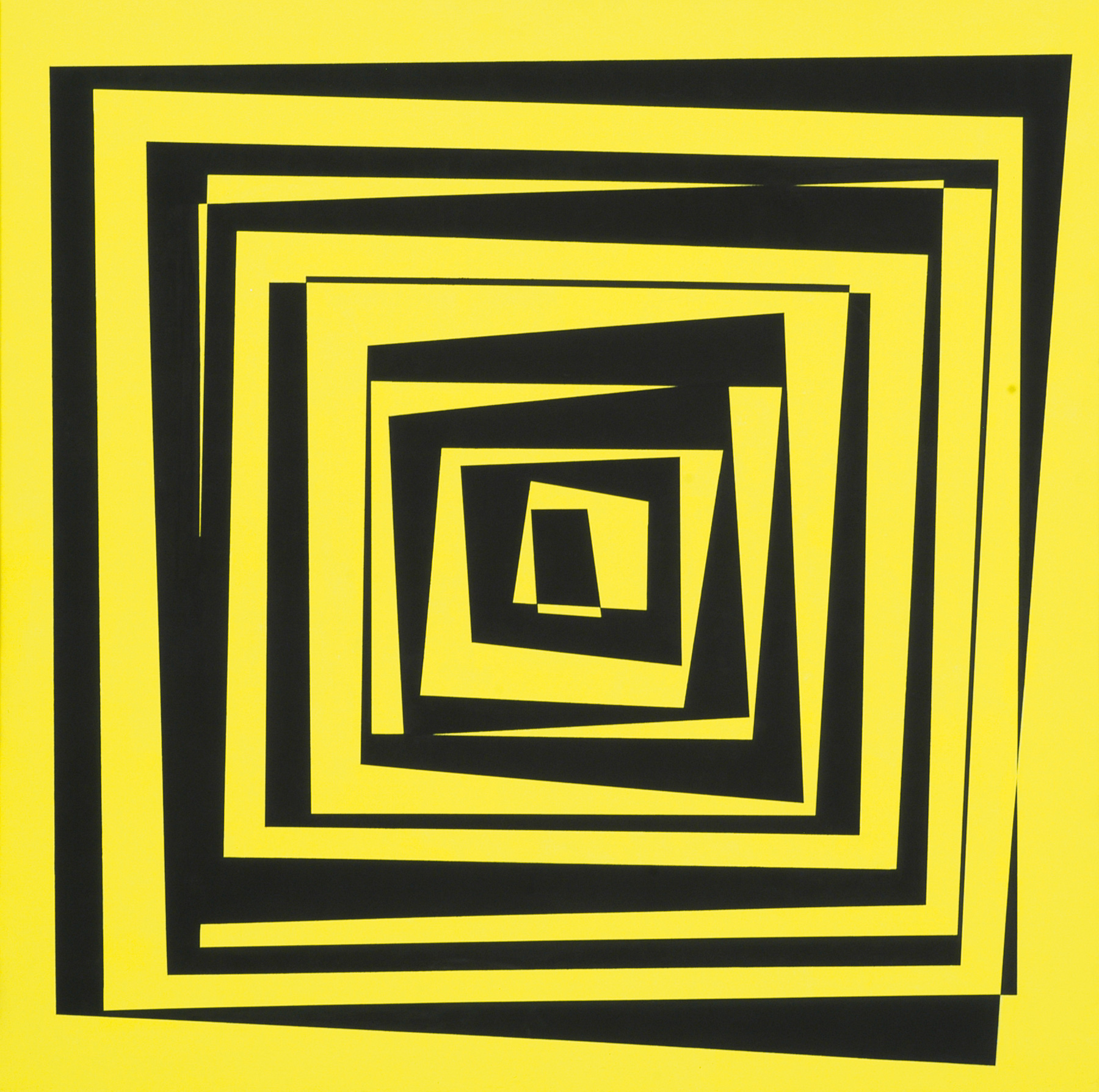
Series: (Dés)Ordres:

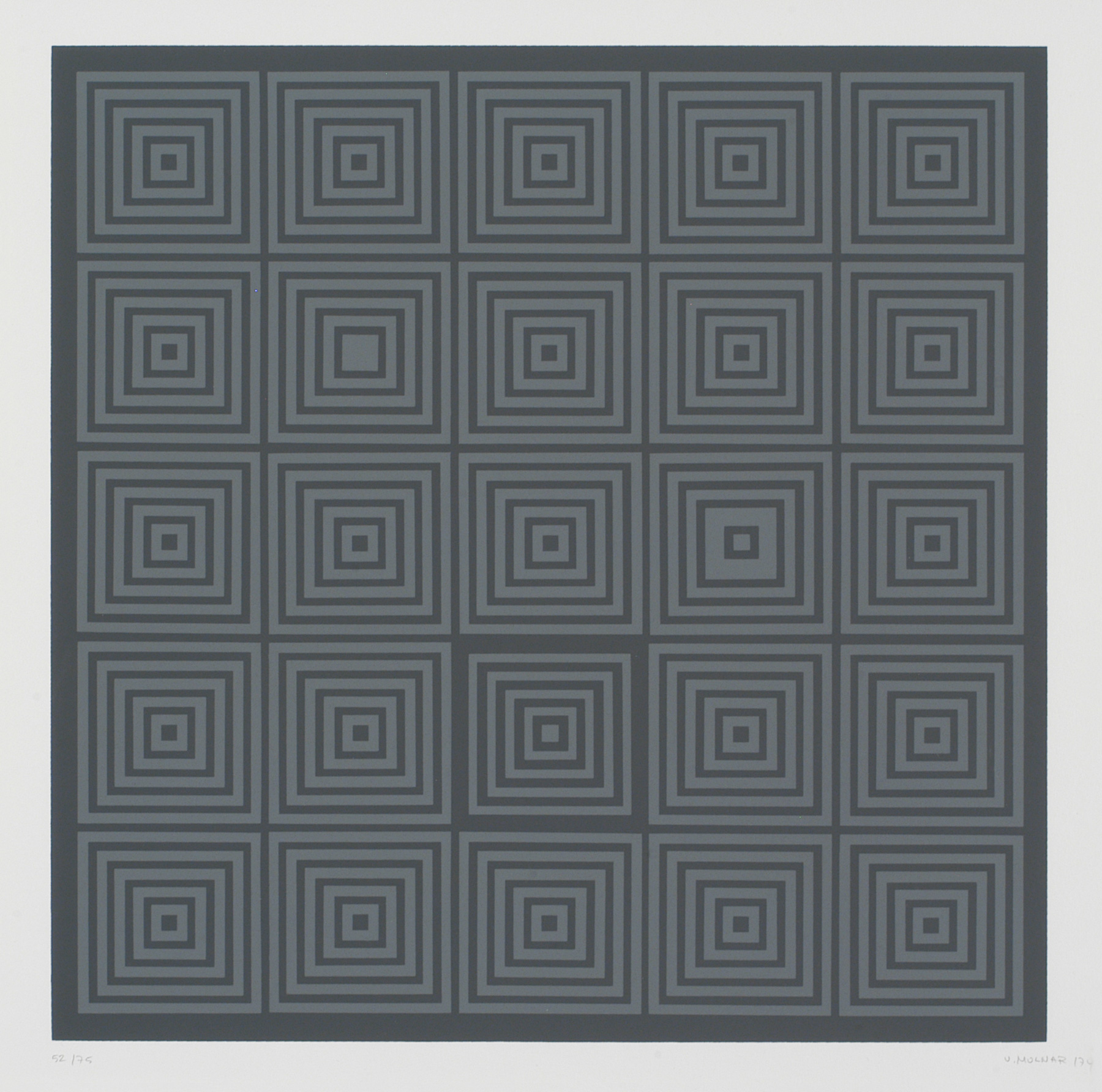
https://www.artsy.net/artwork/vera-molnar-untitled-13-1







Series: Trapèzes:






























Series: 9 Double Dignes:





Series: My Mother’s Letters



https://arena-attachments.s3.amazonaws.com/3925409/28a4730c59ee621e83db6a6fca851cc7.pdf?1553439831







Screen Photography:


Book Works:

This Vera Molnar object-book offers exactly 6,765,201 versions of Montagne Sainte-Victoire (Aix-en-Provence, France).

Reference : https://www.bernardchauveau.com/en/artists-books/230-vera-molnar-six-million-seven-hundred-and-sixty-five-thousand-and-two-hundred-and-one-sainte-victoire-9782363060617.html
Ni queue ni tête is gathered an original drawing by Vera Molnar with a musical composition by Jean-Yves Bosseur
Reference : https://www.bernardchauveau.com/en/artists-books/234-vera-molnar-ni-queue-ni-tete.html
Original Drawing on Paper

Reference : https://computerdrawing.hypotheses.org/197 (it’s originally written in French but you can use google translated it to English)
TIMELINE
| 1942-47 | studied painting and for a diploma in art history and aesthetics at the Budapest College of Fine Arts. |
| ———– | ——————————————————————————————————————————————————————————————————————————————————————————————————————————————————————————————————————————————————————————————————————————————————————————————————— |
| 1946 | first non-representational images are created.
Abstract, geometrically and systematically determined painting. |
| 1947 | artists’ fellowship in Rome at the Villa Julia
moved to France |
| 1947-60 | occasional co-operation with François Molnar |
| 1948 | marriage to François Molnar |
| 1959-68 | works with the machine imaginaire method |
| 1960 | Co-founder of the artist group GRAV (Groupe de Recherche d’Art Visuel (GRAV) (Research Group for Visual Art) was a collaborative artists group in Paris[1] that consisted of eleven opto-kinetic artists)
First participation in an exhibition organized by her friend Max Bill with the title Konkrete Kunst (Concrete Art) in Zürich, Helmhaus |
| 1967 | Co-founder of the artist group Art et Informatique at the Parisian Institut d’Esthétique et des Science de l’Art |
| 1968 | first computer graphics are designed: thereafter continuous work with the computer |
| 1974-76 | development of the Molnart computer software programme jointly with her husband |
| 1976 | first single exhibition ’’Transformations’’ at the gallery of the London Polytechnic |
| 1979 | works at the Centre Georges Pompidou in Paris, at the Atelier de Recherche des Techniques Avancées (ARTA) |
| 1980 | member of the CREIAV at the Université de Paris I, Sorbonne
The first artist’s book ‘’Ein Prozent Unordnung’’ is published by Wedgepress & Cheese in Bjerred (Sweden) |
| 1985-90 | professor in fine arts and aestehtics and art history at the Université de Paris I, Sorbonne
Since 1990 her works are on display at major European exhibitions on non-representational art and avantgarde
The first installative work is created fort he Foundation of Concrete Art, Reutlingen |
| 1999 | large monographic exhibition ‘’Extrait de 100 000 milliards des lignes’’ at the Centre de Recherche, d’Échange et de Diffusion pur l’Art Contemporain (CRÉDAC) in Ivry-sur-Seine |
| 2005 | recipient of the first [ddaa] for her life’s work. |
| 2015 | (Un)Ordnung. (Dés)Ordre. at haus konstruktiv:
From Vera Molnar’s early freehand drawings that have never been exhibited before, to her late-1960s plotter drawings, through to a new installation that was specially conceived for Museum Haus Konstruktiv. Trailer: https://www.youtube.com/watch?v=N3OOrYkpMwU |
| 2019 | Exhibiton in Muda in zürich: https://muda.co/veramolnar/ |
Exhibitions + Installations
https://the-adaa.tumblr.com/post/117788020636/computer-art-pioneer-vera-molnar
Installation Berlin Schöneberg train station

Vera Molnar, Gotique, 1988, installation Berlin Schöneberg train station, blue adhesive tape on window The series ‘Gothique’ was created on the occasion of a commissioned work for the German-French exhibition ‘Construction and Conception’. The show was arranged for the station Schöneberg in Berlin which was still shut down back in 1988. Vera Molnar implemented a work on the windows of the railway’s hall. The installation picks up the existing architectonic structures of the glass front - high and slender like the gothic ideal. “The work is based on an intense reflection concerning proportions. After I had left one of the ideals of forms, the square, behind and lengthened it, I did not go any further than the proportions of the golden ratio allowed… After the cube, after the rectangle based on the rules of the golden ratio, I stuck to the double cubes, the quadruple cube, arriving at the ‘wild’ proportions in the end, e.g. 1:30. In this case it was hardly a rectangle anymore, rather a thick line. More precisely, you find yourself visually ‘in between the two’: neither line nor bar… These elongated rectangles, gothic, truly amazed me as antipodes to the canon of ancient beauty. It was like a healthful shaking at the point on which I had been comfortable with my aesthetic understanding.’ Vera Molnar interviewed by Marc Chauveau, 2010.
Vera Molnar “Drawings 1949-1986” Senior & Shopmaker Gallery
[Image: Vera Molnar “2 Lettres M (du cycle M Comme Malevich)” (1961) collage on cardboard, 8 5/8 x 12 1/2 in.] This event has ended. A pioneer of computer art, Hungarian artist Vera Molnar, born in Budapest in 1924 and a resident of Paris since 1947, has established a prominent position in the field of Constructivist-Concrete art but is virtually unknown in this country. Working in Paris alongside artists such as Francois Morellet, Julio Le Parc, Jesus Rafael Soto, and Victor Vasarely, Molnar was a founding member in 1960 of the Research Group for Visual Art (“Groupe de Recherche d’art Visuel,” or GRAV), which espoused minimal, non-objective image-making, and gave rise to the Op-Art and Kinetic Art movements of the following decade. Still active today at 93, Molnar’s remarkable practice encompasses painting, drawing and collage, computer drawings, photography, and installation. The artist’s second exhibition at Senior & Shopmaker Gallery will feature computer drawings made between 1968 and 1986, as well as a small selection of pre-computer works on paper made between 1949 and 1970. An e-catalogue will accompany the exhibition. Beginning in 1968, the computer became a central device in the making of Molnar’s paintings and drawings, allowing her to more comprehensively investigate endless variations in geometric shape and line. Molnar learned the early programming languages of Fortran and Basic, and gained access to a computer at a research lab in Paris where she began to make computer graphic drawings on a plotter, several of which are included in the exhibition. Using the computer’s high calculation speed and signal capacity to arrive at a large number of variables, Molnar nonetheless insists upon the importance of hazard and chance in the final outcome—by injecting small programming “interferences,” she offsets predictable outcomes.
Molnar’s work has been the subject of retrospectives at the Kunsthalle Bremen, Germany, 2006; the Musée des Beaux Arts, Rouen, France, 2012; and the Haus Konstruktiv, Zurich, Switzerland, 2015, co-organized with the Museum fur Konkrete Kunst, Ingolstadt, Germany. Group exhibitions include Dynamo, curated by Serge Lemoine and Matthieu Poirier, Grand Palais, Paris, France, 2013; Abstraction/Figuration, Musée des Beaux Arts, Rennes, France, 2014; From Minimalism Into Algorithm, The Kitchen, New York, 2016; and Sixfold Symmetry: Pattern in Art and Science, Frances Young Tang Teaching Museum of Art, Skidmore College, Saratoga Springs, New York, 2017. Currently Molnar’s drawings are included in Thinking Machines: Art and Design in the Computer Age, 1959-1989, The Museum of Modern Art, New York, and The Other Trans-Atlantic: Kinetic and Op Art in Eastern Europe and Latin America 1950s – 1970s, Museum of Modern Art, Warsaw, in collaboration with Garage Museum of Contemporary Art, Moscow, and SESC, Sao Paulo. Her work is included in such notable public collections as The Morgan Library and Museum, New York; Musée Nationale d’Art Moderne, Centre Pompidou, Paris; Bibliothèque Nationale, Paris; Kunsthalle Bremen, Bremen; National Gallery, Budapest; and the Victoria and Albert Museum, London.
RELATED ARTISTS
Lillian Schwartz (American, 1927)
Manfred Mohr (German, 1938)
https://studiovisitshow.com/2015/06/28/series-nine/
George Nees (German, 1926-2016)


![]()
Sol LeWitt (American, 1928-2007)
https://publicdelivery.org/sol-lewitt-wall-drawings/

François Morellet (French, 1926-2016)
a French contemporary painter, sculptor, and light artist

Pierrette Bloch (French-Swiss, 1928-2017)
Pierrette Bloch was a French-Swiss artist known her abstract paintings and drawings.
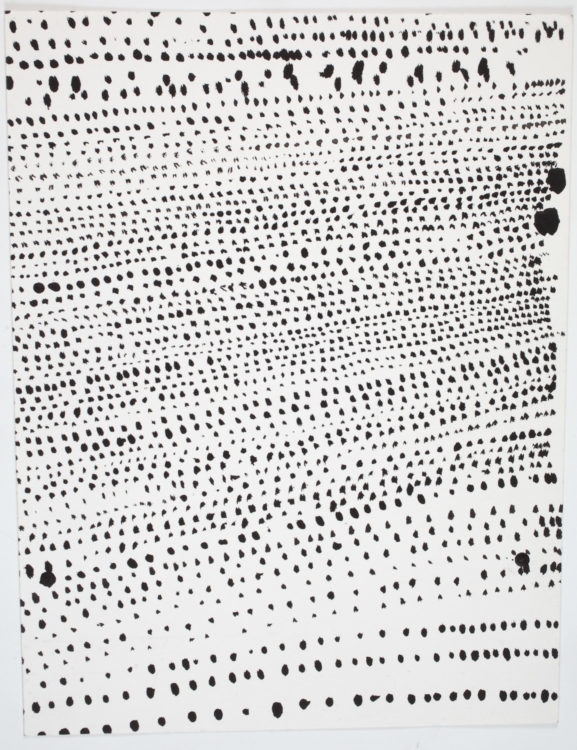
ARTICLES + ADDITIONAL REFERENCES
http://www.vam.ac.uk/content/journals/research-journal/issue-no.-6-summer-2014/cataloguing-change-women,-art-and-technology/
https://www.surfacemag.com/articles/vera-molnar-in-thinking-machines-at-moma
https://oniris.art/artistes/vera-molnar/ Presentation of Vera Molnar (French) - by Galerie Oniris - where she exhibited since 1995 https://oniris.art/wp-content/uploads/2018/07/Molnar-_-Oniris.pdf Her works - Galerie Oniris https://oniris.art/wp-content/uploads/2018/07/Molnar-papiers.pdf
Article (pdf): “Vera Molnar’s Computer Paintings” by ALINE GUILLERMET This article explores how Molnar’s computer-generated works used programming as a means to reflect upon the autographicity of the handmade trace in drawing and painting https://watermark.silverchair.com/rep_2020_149_1_1.pdf?token=AQECAHi208BE49Ooan9kkhW_Ercy7Dm3ZL_9Cf3qfKAc485ysgAAAokwggKFBgkqhkiG9w0BBwagggJ2MIICcgIBADCCAmsGCSqGSIb3DQEHATAeBglghkgBZQMEAS4wEQQMfVssFztuLrpU6GLEAgEQgIICPIpgyLJVzGP4FK8nXeRNVKcQry7eCX_6xehglPXMldmP-6ZUFqBT0D8lCQVgRr7ZBVqX-c_uk7ibxPxAc94PkgObkms3LjJpw1z838FnMuACHWfMdV65GJFMBamjKwOzPLUh7TAQfgenXKzTI8Tnqhv53gSX5OFas2gUUp7fssXVxjBcdPq2gUrfUABtbo-ImdOJaREBrpxHocka0Slmzj-uJ4FCIzrXCH1u1sK-RN37McMW8HgdPyVeSd2-a3u511TqC887xnQSZ0Ufs4OjzKPfzlf8I7HDuQGVfRSFLZrRA0zzZwc7N99VD4YJNwKeIJ9BICvsbHxN7KE9SEeCHnt4pg9OnwZ1pu7rrGq32ShkBVL8ZSRfUbtKa4p6z5z3HbnwRQpC_tWM08MWVEjEGg_xeJfq_lrZU-5o5955HbYyxlMB_KsSfE01HwjKlGWFc4UEzAsnHNVinIeyIJDakddee_NMMq8VxMhCeNshmJPudKphOMqK71i7u0VHUgpXACvJmGy_Hvh9Wku-6NACT4NNukdY9W5Fgxsrc0mD73Fj3ltzcpTJjvsKiHlx2WvLAMvNzoIkF6WSlYAwrVDmDbZnr087sgG6oyU3jIludQZ0FbDkOG7sRrDXRlu-oqDt3OmFzki7N8V2fEcCzLvWQ7SUjbSroIoH2MN-NivTn3ji46b0vU-9eu8IakVZnchO5hi3OH5dzcqb5t7dxs8972SYNV852-XU049UFsgb4Qxj5kQwmMXT_RFMVLjR

Toward Aesthetic Guidelines for Paintings with the Aid of a Computer, Vera Molnár, 1975
https://drive.google.com/file/d/1rxo9oDUEU-WZCbeuZmwByXqpfBkAD5LC/view?usp=sharing
https://drive.google.com/file/d/1rxo9oDUEU-WZCbeuZmwByXqpfBkAD5LC/edit
Vera Molnar’s Exploration of the Unimaginable Rachel R. Roe-Dale: https://www.tandfonline.com/eprint/itr22xpSh6fbm6eSqycd/full?target=10.1080%2F10724117.2019.1568081&
Monoskop article on Vera: https://monoskop.org/Vera_Moln%C3%A1r
Technical Information
Fortran language manual: http://www-eio.upc.edu/lceio/manuals/Fortran95-manual.pdf
Plotters
Contemporary Pen Plotter work
https://mattdesl.svbtle.com/pen-plotter-1
You can buy pen plotter yourself! :) https://axidraw.com/
